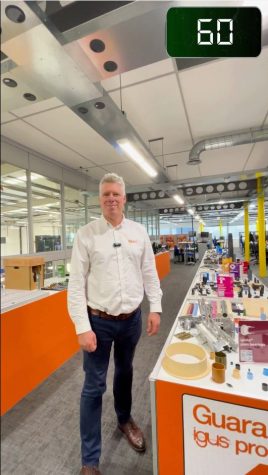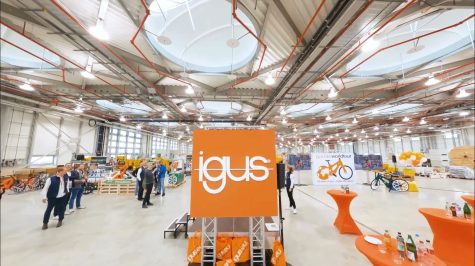For more information on robolink® robot arms visits igus.co.uk/robolink.
How safe is a robot?
Like any tool, a robot is as safe or dangerous as you use it. Cobots are said to not be wholly safe to interact with as one would with a human, and similarly non-collaborative robots are to be treated according to the power, hardware, and tools (or end-effectors) they feature. Helpful guides and contacts for maintaining safety with robots can be investigated via the many British robotics and automation organisations.
How to program a robot
Robot programming is a task that specific engineers are trained for; for simple robots’ tasks, the programming is simpler and more generic than for robots performing tasks such as measuring and analysing a system with the use of many different axes. Various different programmes are available according to the complexity of the tasks, the number of degrees of freedom (DOF) the robot has, and whether or not the robot has autonomy in its tasks.
Why are robots good?
There are myriad benefits that robots can give us, such as easing us from dull or difficult tasks, to increasing efficiency and improving productivity in factories and companies. Robots will not be the best solutions for every task, but with testing and 3D simulations we are able to quickly analyse the application and identify what can best solve the issue.
What are the uses of robots?
Robots can be used for a huge variety of tasks and in many different industries. Industrial robots are used in great car factories for installing large parts such as windscreens, and small, high-precision robots are used in the medical sector for delicate operations such as on the eye. In between, we can see robotic processes happening all around us, from automatic doors on buildings to automatic coffee dispensers.
What is a robot arm?
A robot arm is the nature-inspired mechanical robot which was created as a mechanism which is able to provide human-like dexterity. While a human may not be able to place a windscreen on a car in the production line, a large robot with a 1-tonne payload will be able to solve this. Similarly, the igus® robolink® is able to perform task which are too dangerous or harmful for a human to do, such as assembling parts in a chemical or very dusty environment.
Where is the robolink® used?
Thanks to its flexible nature, long-lasting capabilities and strong payload capacity, the robolink® can be found in myriad industries. The manufacturing industry is a popular one for the robolink® given the repeatable nature of the tasks in and often dirty environment of a factory. Hazardous areas are great for this polymer-based product not just for its consistency within a dusty or chemical area but also with its low absorption of water: it can work while being sprayed with chemicals or water solutions and can therefore resist swelling and machine breakdowns.
How can I see a robolink® myself?
If you are interested in seeing the robolink®, we would like to welcome you to the LCA Suite at our factory in Northampton. Here, you will be able to experience the size of the robolink®, its low and high working speeds alongside a modular igus® gantry and the fast delta robot.
Get in touch with the LCA Product Manager, Adam Sanjurgo, asanjurgo@igus.co.uk below to find out more or arrange a visit to the igus® factory.
What end effectors can the robolink® use?
The robolink® can be fitted with virtually any end effector, provided it is within the payload of the robot. These can include: electromagnet, gripper, suction cup, and many other tools.
What cables can be used on the robolink®?
The robolink® can use many different cables and hoses, from pneumatic pipes to sensor cables. The opportunities are virtually endless!
What sort of robots does the igus® iRC control?
We have three standard robot types that we offer within our range of Low-Cost Automation robots. Each having their place in the world of automation, the iRC has been developed to control all three types of standard robot using the same software and hardware
How much does the igus® iRC cost?
That depends if you are talking about the software or the hardware. Firstly, and most importantly, the actual software itself is completely free; no charge, no licence fee, completely free. You can download the software right now, here. You can simulate all three robots very quickly. Now to the hardware, which isn’t quite so simple to answer, mainly because of the flexibility we offer, the iRC can control 2-axis up to 5-axis robots with the option to integrate vision systems and grippers too. We also have two versions, a cabinet mounted version, and a DIN-rail version for mounting into the customers own cabinet. I suppose the simplest way to answer the question is to say that the iRC starts from around £3,00
Can a demonstration of the software be organised if the customer wants to learn more?
Absolutely. I welcome any customer to get in touch with us and we can organise a suitable day and time for the demonstration, this can be done over video conference or in person. Whichever best suits the customer. What is great about the software is that is it incredibly user friendly and has been designed in a way that mistakes are hard to make.
What maximum payload can the robolink® articulated arm robot lift?
robolink® carries up to 3kg payload. Visit our online shop to find out which versions support which payloads.
What is meant by the range and nominal range of the articulated arm robot?
The nominal range provides the working area in which the robot can operate in the long term. In the short term, the robot can also work in the area of maximum range.
What is the range of robolink® articulated arm robots?
The range of our robolink® extends from 510mm to 790mm. Visit our online shop to learn more about the range of the individual versions of robolink®.
Is the articulated arm robot always the best choice for my application?
There are countless advantages that robots can offer, such as relieving us of boring or difficult tasks, increasing efficiency and improving productivity in factories and companies. Robots will not be the best solution for every task, but with tests and 3D simulations we are able to quickly analyse the application and determine what can best solve the problem.
Whether the articulated arm robot is always the best choice is something we would be happy to discuss with you in a personal meeting, because sometimes other kinematics are easier to integrate into processes.
Which end effectors are used with robolink®?
The robolink® can be equipped with practically any end effector as long as it is within the payload of the robot. This may include electromagnets, grippers, suction cups and many other tools. At RBTX.com, out online marketplace for robotic components, you can buy carious components from our partner suppliers.
Which cables are used with robolink®?
For robolink® you can use many different cables and hoses, from pneumatic tubes to sensor cables. The possibilities are almost unlimited!
You can accommodate 2x8mm cables per side in the robolink® DP. In addition, there are external energy chains for the robolink® DP and robolink® DC, which you can fill easily.
Can I negotiate bends with robolink®?
Only conditionally, because we have to travel to several points on a bend in order to complete the curve. Because the cornering is not quite round.
What does the 7th axis mean?
The 7th axis is a linear axis for moving a robot.
With which manufacturers is the 7th axis compatible and easily integrated?
- Universal Robots UR3, UR5 and UR10
- igus® robolink DP4, robolink DP5, robolink DC
What do I need to control the 7th axis?
For igus robots, the igus® Robot Control.
For UR Robots a UR Cap solution. We offer these in our shop (our part number DDLE-UR-0001)
Which robots can I control with igus® Robot Control?
We have three standard robot types that we offer in our range of low-cost automation robots. The iRC was developed to control all three types of standard robots with the same software and hardware.
- Articulated arm robots
- Delta robots
- Linear robots
What is igus® Robot Control?
The igus® Robot Control is a control system developed to control all robots offered by igus® (articulated arm robots, delta robots and linear robots). With the corresponding software, you can programme and move the robot via a graphical user interface.
You can download and try out the software free of charge in advance. The software has been specially developed to make the introduction to automation as easy as possible. Because the 3D interface is very user-friendly and intuitive to operate.
The control system is available in the switch cabinet or on top-hat (DIN) rail assembly
What is the difference between the top-hat (DIN) rail and switch cabinet version?
- Top-hat (DIN) rail version: serves for integration in your own switch cabinet, 10 metres of motor, encoder & INI cables and all other joining links.
- Switch cabinet version: complete switch cabinet with emergency stop, power supply unit, 10 metres of motor, encoder & INI cables and all other joining links.
Which transmissions are possible with drygear® strain waves?
Currently the transmission ratio is 28:1
Which motor kits can be connected?
NEMA11 and NEMA17 stepper motors
Which end effectors can I mount?
The flange plate is compatible with the common end effectors. The hole pattern with M4 and M6 threads allows flexible connection.
What happens at the failure torque?
The gearbox slips through and no teeth break. You have to open the gearbox and re-align the flex ring, then the gearbox will work again.
What installation sizes of drygear® worm gear are available?
Installation sizes 20, 30 and 50 are currently available and more are being planned.
What installation sizes and ratios of the worm gear are available?
At present we offer the 20, 30 and 50 installation sizes and ratios from 5:1 to 70:1.
Are spare parts available?
Yes, you can also order the worm wheel and worm shaft separately from us.
When do I use worm gears with PRT or ball bearings?
PRT:
- Higher axial load bearing capacity
- For impact loads
- Use: horizontal applications with impact loads, high loads or eccentric loads, rotary axes, rotary indexing tables
Ball bearings:
- Less clearance
- Higher efficiency
- Use: vertical applications, robot gearboxes
drygear® Apiro- Which gearbox models are available from stock at igus?
We currently have all gearbox models in stock in small quantities.
drygear® Apiro-Which transmissions are possible?
Available are 4:1, 32:1 and 64:1.
3:1, 8:1 and 16:1 are also optionally available.
drygear® Apiro-When to use which transmission?
4:1 for very fast rotational movements
32:1 for high loads
64:1 for self-locking and precise positioning
Which motor kits can be connected for the drygear® Apiro?
All drylin® E DC motors, as well as all stepper motors in NEMA11, NEMA17 and NEMA23 installation sizes.
What is the maximum and minimum stroke for the cantilever axis?
Min. 53mm
Max. 1042mm
Is the Apiro gearbox suitable for splash water and underwater applications?
We have a special model for this application, which we can offer upon request.
What torque can I transmit with the Apiro gearbox?
4:1 with 2.5Nm
32 with 1Nm
64 with 1Nm
For which applications can components from the drygear Apiro modular gearbox system be used?
Our drygear Apiro modular gearbox system allows an infinite number of possible combinations for the most diverse applications. This may include
- Rotary axes,
- Lane adjustments,
- Pusher applications
- or Cartesian robots





